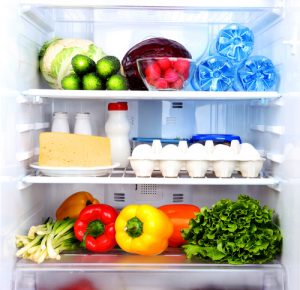
Ever wonder why your refrigerator has so many different compartments and labeled drawers? The answer isn’t just for organization’s sake. In fact, it might even surprise you to learn that your refrigerator’s content management is more about energy efficiency than ensuring you can find what you’re looking for. That’s right; not only is using an energy efficient refrigerator a good idea, following it’s organizational system is too. If you’re wondering exactly how this works, Southern California Edison has provided a great infographic that we’ll discuss here.
Top Shelf
The top shelf of your refrigerator has the most consistent temperature and should be used to store items that don’t need cooking. In other words, leftovers, beverages, and things like tortillas and dips are the best options for the top shelf. If you invest in glass containers, your leftovers will last even longer.
Lower Shelf
The lower shelf is the coldest part of your refrigerator. Here is where you want to keep raw ingredients such as raw meats, dairy and seafood. These are ingredients you will use for cooking and are highly perishable.
Side Doors
Most of us use the side doors to hold anything we can stuff into them, and that’s generally what they’re supposed to be used for. Condiments such as mayonnaise, salsa, ketchup, pickles, salad dressings and nut oils are what you want to keep here. Outside of those items, they’re also a great place to store juices and water.
Drawers and Door Compartments
Your side door compartments are where you want to keep your butter and cheeses, because they’re designed to house them there. Vegetables should be kept in the high humidity drawer in their original packaging or a loosely tied plastic bag. Keep fruits in the crisper or low humidity drawer, and never store your fruits and vegetables together. This is because fruits produce a chemical called ethylene which causes them to ripen. It works so well it will actually cause your vegetables to yellow, wilt, and even sprout. If you have a meat drawer, you’ll want to store your raw meats there. Otherwise, you’ll want to use the lower shelf mentioned above.
In Conclusion
It might seem unnecessary to follow these guidelines, but they are designed to make your refrigerator run more efficiently. You’ll find you can keep your temperature at a constant, energy efficient level and your food will stay fresher, longer. It’s recommended to set your temperature between 35ºF and 38ºF, as even 10ºF cooler can use up to 25% more energy. With these tips, you’re well on your way to a fresher, more energy efficient kitchen in no time.
